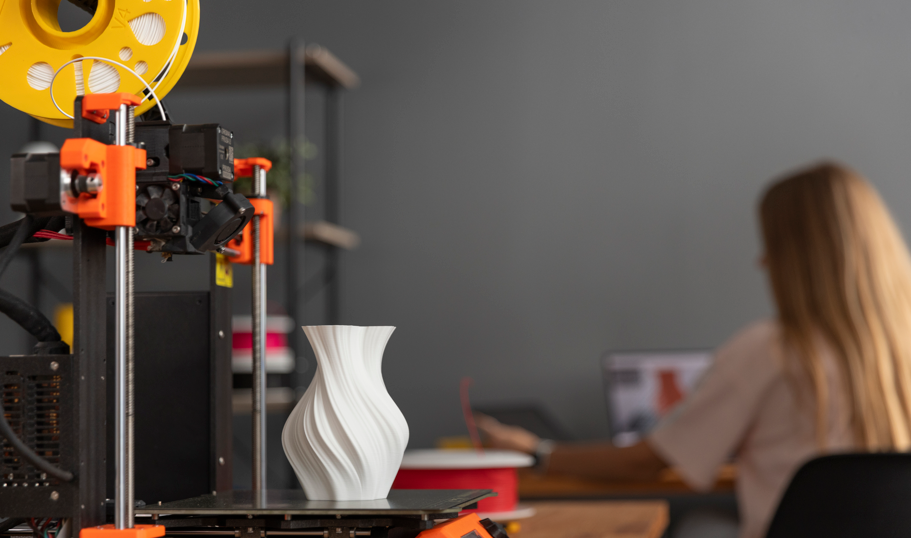Because it provides a highly effective and economical way to produce complex objects, 3D printing has rapidly become a transformative force that is upending industries. Fundamentally, 3D printing is the process of creating tangible objects from a digital design layer by layer, frequently using materials like metal, plastic, or even food-based materials. In addition to cutting waste, this move away from traditional manufacturing opens up new creative and design opportunities, such as personalized medical implants and jewelry.
3D printing is especially innovative because it revolutionizes the manufacturing process. In contrast to subtractive techniques, which involve removing solid material layer by layer, 3D printing adds material exactly where it is needed. From dental implants to aircraft components, this incredibly effective method enables the production of complex and customized shapes without wasting extra material. Reduced waste and the capacity to design and manufacture objects with intricate geometries that would be impossible with conventional methods are two remarkably obvious advantages.
| Industry | Application | Material Used | Impact |
|---|---|---|---|
| Healthcare | Prosthetics, implants, surgical guides, dental applications | Titanium, plastics, bio-materials | Personalized, faster, and cost-effective medical solutions |
| Automotive | Prototyping, production parts, tool creation | Various metals, plastics | Rapid prototyping and lightweight, durable components |
| Fashion | Custom clothing, shoes, accessories, and jewelry | Plastic, metal, fabric, and composite materials | Customized, on-demand fashion items with unique designs |
| Aerospace | Parts production, tools, aircraft prototypes | Aluminum, titanium, special composites | Stronger, lighter materials improving fuel efficiency |
| Construction | 3D printed homes, architectural models, custom components | Concrete, polymers, metal alloys | Sustainable building practices, rapid construction timelines |
| Art and Design | Sculptures, art installations, jewelry designs | Various materials including plastics and metals | Enables artists to experiment with new shapes and techniques |
3D printing has significantly changed the timeframes for product development in sectors like healthcare, aerospace, and automotive. Prototyping used to be a time-consuming procedure in these industries that required weeks of work and substantial resources. Prototypes can now be printed in a fraction of the time, allowing businesses to test and improve designs instantly. This speed helps firms stay competitive in quickly changing industries by cutting development costs and speeding up time to market. This technology is extremely versatile because it allows for rapid design iterations without the need for costly molds or tooling.

3D printing technology is revolutionizing production as well, not just prototypes. 3D printing gives manufacturers a new way to approach production by printing anything from custom products to functional parts. Small batches of customized parts can now be produced by businesses for a fraction of the price of traditional manufacturing techniques, which is drastically changing how sectors like consumer electronics and the automotive industry function. For example, manufacturers of automobiles use 3D printing to create lightweight parts that increase fuel economy, and businesses in the medical industry are producing implants and prosthetics that are specifically suited to each patient’s requirements.
The increasing demand for sustainable manufacturing practices aligns with the growth of 3D printing. 3D printing lessens the negative effects of production on the environment by minimizing material waste and enabling the recycling of used materials. The technology offers a significant chance for industries to lower their carbon footprint because 3D printers can use a wide range of materials, including metal alloys and recycled plastics. Furthermore, the environmental impact of conventional manufacturing and shipping methods is further decreased by the ability to print products on demand, which does away with the need for extensive storage.
3D printing has also opened up new possibilities for creativity and personalization in sectors like fashion. Today, both designers and consumers can produce personalized apparel and accessories, expanding the realm of fashion’s potential. For instance, some designers have worked with 3D printing businesses to produce elaborate clothing that exemplifies how high fashion and technology can coexist. 3D printing is being used by celebrities and stylish people to make unique products, pushing personalization to new limits. Large-scale production of custom fashion items is made feasible by the highly adaptable and effective process of designing complex, detailed designs.
3D printing appears to have a bright future. The possible uses for this technology are growing quickly due to continuous improvements in printing, software, and materials. The advancement of 3D printing technology that can handle a greater variety of materials, such as metals and composites used in the automotive and aerospace sectors, is one area of emphasis. The time and expense required to produce high-performance parts could be greatly decreased as a result. Similar to this, developments in multi-material printing create new opportunities for creating increasingly intricate goods that integrate the advantages of multiple materials into one cohesive unit.



